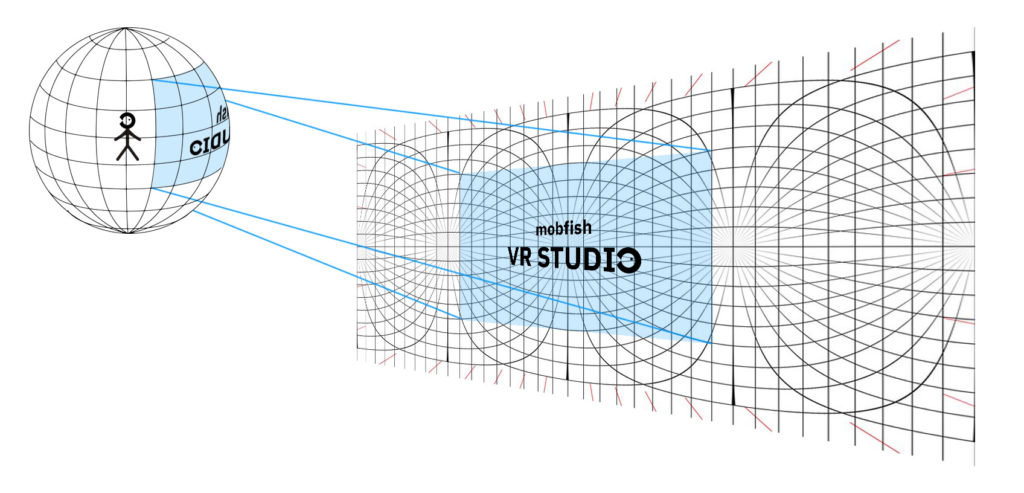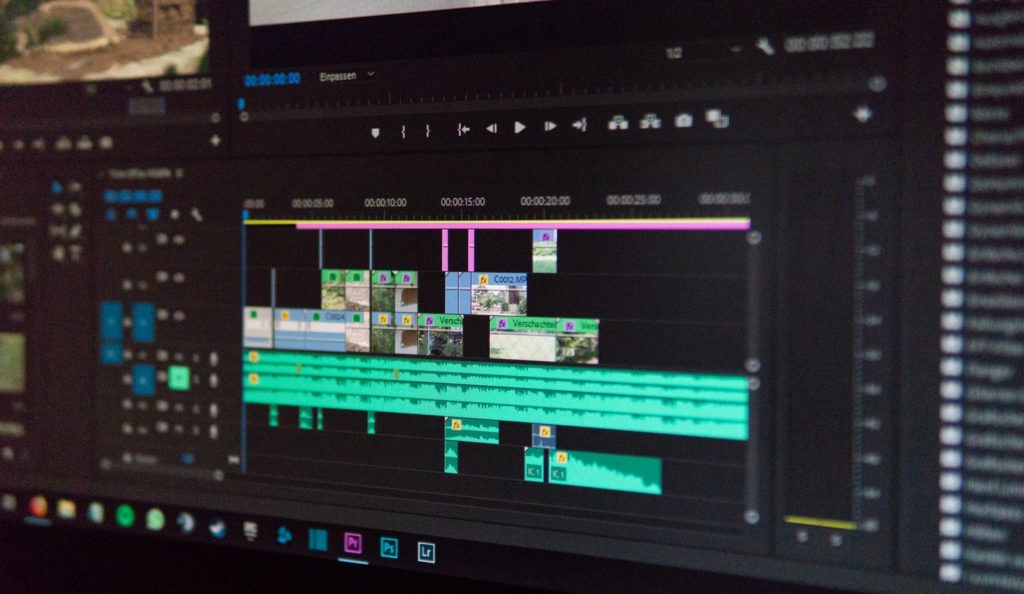VR APPS ONLINE!

For some time now, Virtual Reality videos have been popular with the masses on platforms like YouTube and Facebook.
But what formats are there and what are the technical specifications? On which platform does what run and how do I have to export it?
Table of Contents

If you are still relatively new to the subject of Virtual Reality, here are all the important terms that you need to know about VR video formats.
Already familiar with all of this? If so, you can skip this chapter and move to the next!
Stereoscopy creates the impression of depth that is not actually there through the reproduction of images. In everyday language, this equates to 3D.
This is not completely correct as it is only a 2D image giving the impression of 3D.
In practice, it works in such a way that a separate image is created for each eye. Monoscopic images are the 2D images with which we are familiar. A 360° image is also monoscopic in most cases.
As the name suggests, 180° is only half of the sphere.
This format was created because many 360° producers have difficulty filling the whole room with action. In addition, you will have noticed that most VR video viewers predominantly look straight ahead of them.

The current hardware only has limited performance capability. By using 180°, you can achieve significantly higher pixel densities and frame rates. This way, a much better display is possible.
Modern 360° cameras can now record up to 11k videos (such as the Titan from Insta360). The bottleneck at the moment is still the devices on which the media is played.
As an example, the Oculus Go can decode high-resolution videos of up to 5.7k. However, in this article they also give a helpful description of how some coding workflows with large files can lead to so-called damage artifacts.
For example, the following maximum video resolutions are recommended for the Oculus Go in particular:
| Resolution | FPS | Codec |
| 2880×2880 | 60 | H264, H265 |
| 4096×2048 | 60 | H264, H265 |
| 3840×3840 | 30 | H264, H265 |
| 4096×4096 | 30 | H265 |
| 5120×2560 | 30 | H264 |
| 5760×2880 | 30 | H264 |
Since these values differ from device to device, a maximum resolution of 4K is recommended as a general rule.
In general, the bitrate of a video describes the number of bits per second. It affects the size and the quality of the video and audio files.
In general, the higher the bitrate, the better the quality of a video and the larger the file size.
The frame rate is displayed in “frames per second” (FPS). It indicates how many “frames” or individual images are played in one second.
The higher the frame rate, the more fluid the sequence is. For example, movies start at 24 fps, whereas animations usually only require 14 fps.
The aspect ratio is the ratio of the width to the height of a video. It is always written in the following form “width:height”.
Let’s take the following scenario as an example:
A video has a width of 2000 pixels and a height of 1000 pixels. So the width of the video is twice as long as the height. This results in an aspect ratio of 2:1.
Both values describe pixel density. PPI (pixels per inch) only refers to the display. In other words, how many pixels are distributed on a surface.
PPD (pixels per degree ) is more suitable for comparing displays and VR glasses, since this measurement also includes the viewing distance.
People with a normal visual acuity can no longer perceive a difference when the PPD is above 60. To put it in practical terms: the viewer cannot tell the difference between an image with 60 pixels per degree and an image with 90 pixels per degree.
A screen that I only look at from a distance therefore needs a much smaller PPI value than a screen I look at with VR glasses, usually from a close distance.
This term describes normal visual acuity measured at a distance of 20 feet.
With a visual acuity of 20/60, you would have to get 20 feet away to see something clearly that someone with normal vision could see at 60 feet.
DOF = degrees of freedom. This describes the number of directions in which the glasses can move in the room.
This means that 3 DoF glasses, such as the Oculus Go or smartphones, can only detect where the head is aligned. With 6 DoF glasses, however, roomscaling is also possible just like with theOculus Quest.
It’s not that simple! In normal VR videos, you can turn your head, but are not able to move around.
Facebook has introduced a newhigh-end camera in cooperation with the well-known camera manufacturer RED Cinema. This is able to capture 6 DoF videos. Using this format, you can already take your first steps in the music video “The Cooties”. You can find this music video in the Windows Store and watch it using the Windows Mixed Reality glasses.
VR video started out with 360° formats. In the meantime, the 180° format has also been created, which offers the advantage that only half of the room has to be prepared for the shoot.
Furthermore, higher pixel densities can be achieved by using this format. I’ll go into that a little more in detail later.
At first glance, VR videos generally seem to have a high resolution. In the end, however, you only see a small section through the glasses. That means that when I project a 4k VR video in 360° onto the sphere, I don’t look at the whole picture like on a TV, but instead only at a small part, as the following image shows:

Current standalone VR glasses such as Oculus GO or Pico G2 only support 4k.
Thanks to the innovative approach of the Oculus stripe format, you can use a small trick to make 5k possible. However, this has only been used in a few cases so far, for example in the Oculus in-house production “Henry”.
On the other hand, PC-based glasses such as HTC Vive or Windows Mixed Reality offer significantly higher resolutions.
Unfortunately, the low resolution of the integrated displays did not achieve noticeably better results.
There are headsets in development like the Pimax 8K, but these are currently only designed for specialist retailers and are still very expensive.
A second important factor for VR videos is the frame rate. This should be at least 30 fps, but it would be better if it was 60 fps. In the future this should be more. At the moment, however, 60 fps is the maximum that the hardware can achieve.
This is particularly relevant when it comes to motion sickness or cyber sickness in VR. A higher frame rate means the content is more fluid and more compatible for the viewer.
360° videos are not the same as 3D videos!
However, it is possible to record 3D (stereoscopic) videos in 360° or 180°. This increases the immersion.
Special cameras such as the Insta360 Pro are used for this purpose.
The classic 360° camera has 2 lenses. However, there must be at least 4 lenses for stereoscopic images. For example, this is the case with the Vuze camera. For the Insta360 PRO, however, 6 lenses are required.
In the meantime, there are also hybrid cameras that can take a monoscopic 360° picture when folded up and can be opened to a stereoscopic 180° camera. For example, this is the case with the Insta360 EVO.
Stereoscopic imaging is much more practical and immersive at 180°.
At the moment, the mp4 container with the h264 codec still dominates the VR market, although this codec is already quite outdated. Nevertheless, it is still the best option for most applications. This is because almost every piece of hardware supports this codec.
The situation is completely different with h265, which is still supported by very few devices.
The problem with both codecs is that they incur license fees. For this reason, an alliance consisting of Google, Microsoft, Netflix… launched an initiative for an open source codec. This is called AV1.
We can only guess whether and to what extent this will become a reality in the future. However, AV1 does have a good chance thanks to its open source status.
| Headset | PPD | Field of View |
| Oculus Rift | 13.5 | 95° |
| Oculus Quest | 16 | 95° |
| Oculus Go | 15 | 95° |
| HTC Vive | 11 | 110° |
| HTC Vive Pro | 15 | 110° |
| Playstation VR | 10 | 100° |
There are already manufacturers who are experimenting and working with higher resolutions and wider fields of vision. However, these glasses are not yet suitable for this application and are mainly just made available to developers.

Adobe Premiere is best suited for editing VR videos and runs on Mac or Windows. All the necessary functions are directly intregrated to help you become immersed in the editing of the VR video.
It is even possible to connect a VR headset and cut it in VR. However, this requires a computer with high processing power.
Tutorial for editing VR videos on Adobe:
We highly recommend the Creator Up videos with Hugh Hou, who always tests the latest cameras and headsets. He gives helpful tips for VR video editing with Adobe Premiere.
Final Cut is still popular with Mac users. This especially the case since, in contrast to Premiere, no monthly fee has to be paid. Instead, there is just a one-off fee.
Apple explains how to edit videos in Final Cut in this article: “Editing 360° videos in Final Cut Pro X 10.4”.
The PowerDirector produced by Cyberlink is much cheaper than Premiere. Just like the Mac alternative, you only have to pay a one-off amount for the software. Monthly or annual costs may be incurred when using the backup or cloud services.
In contrast to Premiere, however, users of this software have to make a few cuts in the features. For video editing beginners, though, this is definitely an alternative to consider.
It is often not necessary at all to use extra software to export 360° or VR videos. Instead, it is much more a question of the quality standards.
Most manufacturers, such as Insta360, Samsung Gear 360 or Vuze etc., usually also offer an app for their cameras. These apps usually have several features available on them. Among other things, you can also directly export photos or videos.
However, it should be noted that the quality of stitching and the export varies from app to app. Here you simply have to check whether you are satisified with the output quality. You can always use extra software afterwards if you are not satisfied.
It goes without saying that you will want to watch your videos once you have created them. There are different players for this. I will explain some of them in the following sections.
VR content is really fun when it is interactive. Users that can experience your content and interact with it are the ones that feel truly involved. They can influence processes and are part of your whole story, experience or whatever you want to call it!
This is exactly what our mobfish VR STUDIO software specializes in. Interested? If so, have a look round our website and discover what the mobfish VR STUDIO can do!
There are several options on how to view your content directly after you’ve exported it.
On a desktop computer, this is best done with the GoPro VR PLAYER or the VLC-Player, which has been supporting 360° videos since version 3.0.
An advantage of the GoPro Player is that it can be directly connected to a VR headset. This way, you can see your video on your VR device as well.
If you are not one who wants to install any extra software for it – you can breathe a sigh of relief! The standard Windows Media Player is also able to play most 360° content.
Social networks are a great way of sharing your 360° videos. Facebook and YouTube are best suited for this.
YouTube states in its documentation that it is best to upload an equirectangular image with a resolution of 7168 x 3854 to 8192 x 4096 pixels. The following frame rates are also supported: 24, 25, 30, 48, 50, 60.
Facebook recommends a resolution of 5120 x 2560 for monoscopic images and 5120 x 5120 for stereoscopic images, each with a frame rate of 30fps.

Henry is an original animated film made by Oculus Story Studios and can be played on all Oculus devices. Henry is a hedgehog who loves to hug others. However, because the others don’t like this, he has to celebrate his birthday on his own. On this birthday, he asks for something that changes everything.
It is really worth watching the trailer for the 3rd season of the YouTube original series “Escape the Night”. It has been very elaborately produced. The unique thing is that this trailer was produced in VR180. You literally dive into the serie’s world.
As you would expect from Robert Rodriguez (Director of Sin City), this film is not for the faint hearted. You really get thrown into the midst of the action and are part of the story. Since the camera moves a lot, this is not for people who may suffer from motion sickness.
Which tools or cameras do you enjoy working with? Have you had any bad experiences with software or cameras that you would like to share with other VR users?
If so, feel free to leave a comment. We would love to hear from you!
Register for free and start editing!